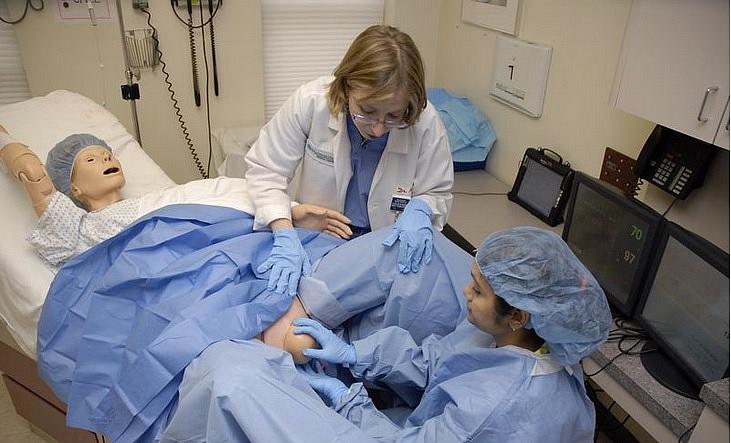How one Brooklyn hospital runs drills to improve maternal health
This reporting series, “What Hospitals Deliver,” was produced as a project for the Center for Health Journalism's 2016 National Fellowship, a program of the USC Annenberg School of Journalism.

Maimonides Hospital delivers more babies in a year than any other hospital in New York State. (Maimonides Medical Center )
“Doctor, the patient just delivered, and she started bleeding, and I don’t know what to do. Today’s my first day.”
Dr. Allison David runs in to take over. She begins asking questions about the timing of the delivery, the size of the baby, vital signs. Blood pours onto pads on the floor.
David calls for medications and a special ‘balloon’ to reduce bleeding,’ but the situation quickly becomes worse. The patient is becoming faint. David makes the call.
“You’re bleeding entirely too much,” she says to the mother, before turning to an assistant. “This is fourth baby, correct? We’re going to take this uterus out.”
As she preps for emergency surgery, David questions another colleague, Dr. Fouad Atallah. And that’s enough to break the spell.
“Is that it?” Atallah says. “Okay — cut!”
“Literally!” chimes in a medical resident, and the others laugh.
The simulation drill for severe hemorrhage was over, and the senior doctors debriefed David about what went well and what didn’t. They tested her skill at estimating blood loss, which is crucial to determining whether the patient needs a blood transfusion or emergency surgery.
Dr. Nelli Fisher, the director of simulation, pointed out that while David appropriately asked for backup from other personnel outside the room, she neglected to call “Code H,” with H for hemorrhage.
“It tells exactly who needs to come without you needing to ask for specific people,” Fisher said. Six doctors, nurses and residents get immediately paged, and 11 other phone calls go out, when a Code H is called.
Exercises like this are a key part of what keep deliveries relatively safe at Maimonides, while women in other Brooklyn hospitals — several not far away — face much higher rates of life-threatening complication. Maimonides’ patients don’t have the highest level of chronic illness that other facilities face but, with about three-quarters of the obstetric patients on Medicaid, it doesn’t have the healthiest population, either.
Maimonides had a hemorrhage-with-transfusion rate of 22 cases per 10,000 in 2013-2014, the most recent years available, according to state figures. The median among the state’s large hospitals was around 70 but at some nearby hospitals the rates, staggeringly, were in the hundreds. These statistics are ‘risk-adjusted’ to reflect the underlying health issues of the hospitals’ patient populations, so they can’t just claim their labor and delivery ward receive more chronically ill mothers with diabetes, hypertension and asthma.
A New York City Health Department analysis declared central Brooklyn the epicenter of potentially fatal childbirth complications, or what public health experts call Severe Maternal Morbidity.
Maimonides has several advantages over nearby hospitals, and not just because its local community is somewhat healthier. It delivers more babies than any other hospital in New York State, about 8,500 annually. With that many births, the staff gets a lot of practice on emergencies, even without being a referral center for high-risk patients. The high volume also justifies keeping on staff a number of specialists who would be too costly for smaller places to employ for relatively infrequent use.
Severe hemorrhage is one of several complications that many hospitals in New York have been trying to reduce. Most are participating in a “Safe Motherhood Initiative,” sponsored by the state chapter of the American College of Obstetricians and Gynecologists. But some hospitals have more resources than others, whether it’s technology like the $3,500 “Noelle” dummy the Maimonides team uses for drills or available staff to cover labor and delivery while others are in the simulation lab.
Still, experts say many elements of Maimonides culture of patient safety aren’t dependent on patient volume or financial resources.
The pillars of that culture include standardized guidelines and protocols, procedural checklists and post-incident reviews to determine what went wrong and whether it could’ve been prevented. Creating an atmosphere where these conversations “take place without fear of retribution” is key, Atallah said.
And simulations aren’t just for hemorrhages and other emergencies. Sometimes during demonstrations, senior doctors will make intentional errors to see if anyone notices and speaks up.
“People don’t want to do it,” said Dr. Howard Minkoff, the chairman of Obstetrics and Gynecology. “They’re always concerned it’s going to be held against them, if you make a superior look bad. But it’s absolutely crucial.”
[This story was originally published by WNYC.]

